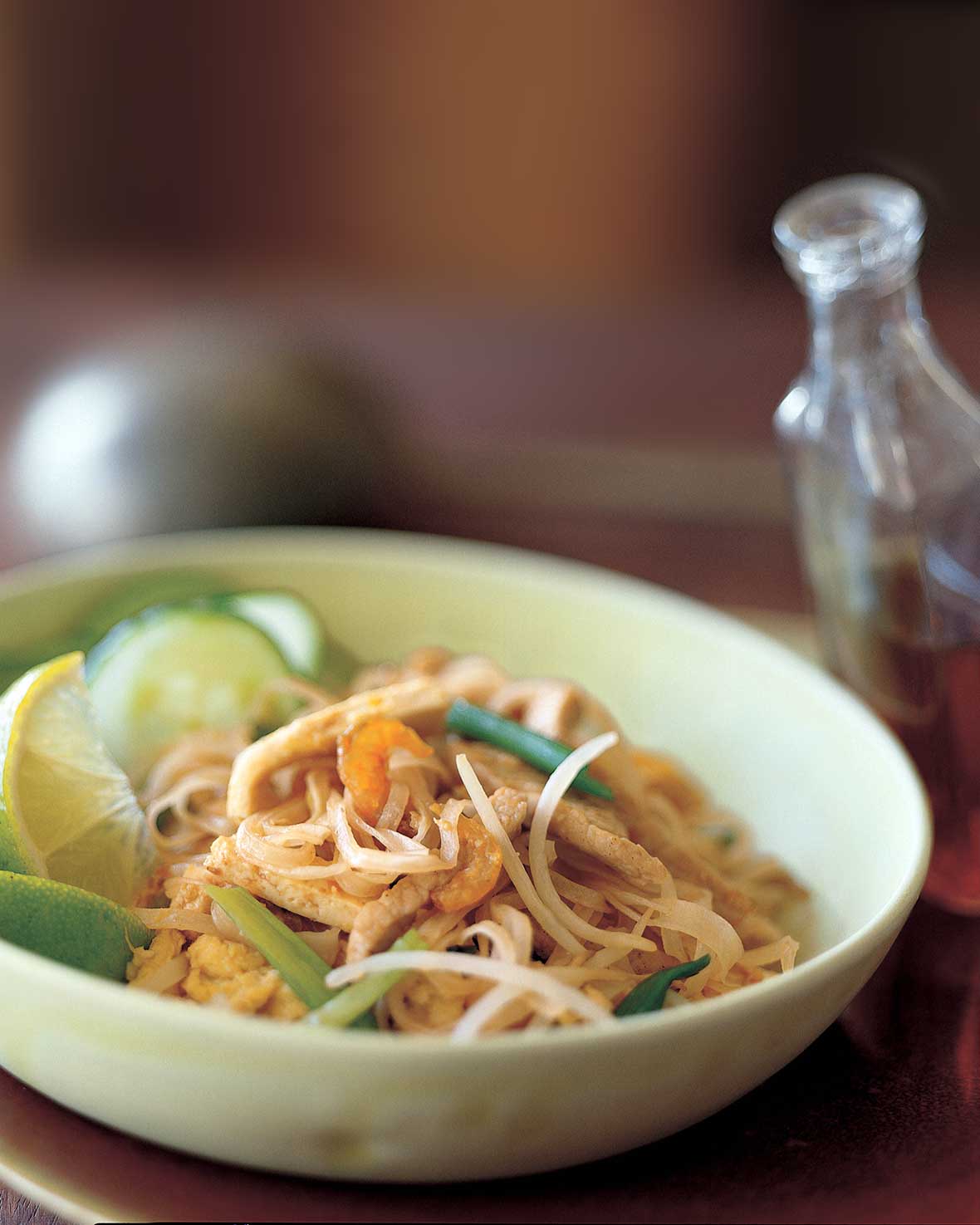
There are a lot of pad Thai recipes out there. Wait. Let us rephrase that. There are a lot of Americanized, imposter pad Thai recipes out there. But you’ll find no sham substitute ingredients such as ketchup or peanut butter here in place of tamarind or fish sauce. [Full disclosure: Our recipe does cede that the arguably scary-sounding salted radishes and dried shrimp can be made optional.] Any way you make our recipe, it’s the closest we’ve found to actual pad Thai during our decades-long quest—and we’ve tried a lot of recipes. As the authors note, “it’s a satisfying one-dish noodle stir-fry, dry rather than sauced, and full of different isolated flavors that come together in a balance of salty, sour, and sweet. There are salty peanuts, soft pieces of cooked egg, a little succulent pork, and seared pressed tofu, all scattered throughout pan-seared thin rice noodles. Once you have your ingredients prepared, your cooking time is less than 6 minutes.” Sign us up.–Renee Schettler Rossi
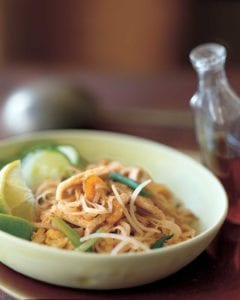
Authentic Pad Thai
Ingredients
- 1/2 pound narrow dried rice noodles
- 2 ounces boneless pork, thinly sliced and cut into narrow strips about 1 1/2 inches long
- 1 teaspoon sugar, (preferably palm sugar although light brown or granulated will work just fine)
- 1 heaping tablespoon tamarind pulp dissolved in 2 to 3 tablespoons warm water, (or substitute 1 tablespoon rice vinegar plus 1 tablespoon water)
- 1 tablespoon soy sauce
- 1 tablespoon fish sauce
- 3 large eggs
- pinch salt
- 3 tablespoons peanut oil or mild vegetable oil
- 2 to 3 cloves garlic, minced
- 2 to 3 ounces firm tofu, cut into narrow strips about 1 1/2 inches long
- 1/2 pound (a scant 4 cups) bean sprouts, rinsed and drained
- 3 scallions, trimmed, smashed with the flat side of a knife and cut into 1 1/2-inch lengths
- 1 tablespoon dried shrimp, (optional)
- 1 tablespoon salted radish, (optional)
- 1 cup roasted peanuts, coarsely chopped
- 2 to 4 tablespoons cilantro leaves, (optional)
- Chile-Vinegar Sauce
- 1 lime, cut into small wedges
Instructions
- Soak the rice noodles in very, very warm water for 20 minutes.
- Meanwhile, place the pork in a small bowl, add the sugar, and toss to coat. In a medium bowl, combine the tamarind water (or rice vinegar and water), soy sauce, and fish sauce. In a small bowl, lightly beat the eggs and a pinch of salt. Place all 3 bowls near the stovetop.
- Place a large wok or ginormous skillet over high heat. (You need a large wok to prepare this amount of noodles, as the noodles take up a lot of room, and you need to be able to push some ingredients up the sides of the wok while you cook other ingredients. If your wok is small, make this recipe in two batches.) Add about 1 1/2 tablespoons of the oil to the pan. When the oil is hot but not smoking, add the garlic and stir-fry briefly just until it begins to change color, about 15 seconds.
- Toss in the pork and stir-fry until the pork changes color but isn’t cooked through, less than 1 minute. Add the tofu and press it against the sides of the wok with your spatula to scorch it a little, 10 to 20 seconds. Pour in the egg mixture and let it cook just until it starts to set around the pork and tofu, less than 1 minute. Use your spatula to cut the omelet into large pieces, then transfer everything to a plate and set aside.
- Return the wok to high heat. Add the remaining 1 1/2 tablespoons oil and swirl to coat. Toss the drained noodles into the wok and stir-fry vigorously, pressing them against the hot wok briefly to sear them, then turn them and press them against the side of the wok again. The noodles will initially seem dry and unwieldy, but don’t worry, just keep folding them over and pressing them onto the wok. After about 1 minute, they will have softened more and be warm.
- Move the noodles up the sides of the wok and toss in 2 to 2 1/2 cups of the bean sprouts and the scallions. Stir-fry vigorously for about 20 seconds, pressing them against the hot wok and turning them so they wilt. Add the dried shrimp and salted radish, if using, and toss briefly with your spatula, then add the soy sauce mixture. Stir-fry for about another 30 seconds, gradually incorporating noodles into the bean sprout mixture. Add the reserved egg-meat mixture and toss gently to mix everything together.
- Turn the noodles out onto a platter or onto individual plates. Sprinkle some of the chopped peanuts onto the noodles, then place the rest of the peanuts in a bowl as a condiment to be passed on the side so folks can add extra as they wish. Do the same with the cilantro. Place the remaining bean sprouts in a bowl and set them on the table. Pass the Chile-Vinegar Sauce and the lime wedges.

Nutrition
Nutrition information is automatically calculated, so should only be used as an approximation.
Recipe Testers’ Reviews
I have made Pad Thai before, using 2 different recipes, and each time my guests said that it was the best Pad Thai they have ever had. This recipe was a little different from the others in ingredients, proportions and cooking steps, so I was a little skeptical. The end result was just delicious. The noodles had a nice texture, and the taste was lovely.
I did substitute fresh shrimp for the pork and didn’t use the dried shrimp or salted radish. The next time I make this, I might add a little palm sugar to the soy/tamarind/fish sauce mixture. I ate the noodles with the chile-vinegar sauce and found that it added some needed moisture and a great, slightly tingly flavor.
If you think this is the typical Pad Thai you get at an average Thai restaurant here in the States, you are wrong. As soon as I saw this recipe, I jumped at the opportunity to try it and see the reaction of our “Thai daughter,” our exchange student. None of us here at home are big fans of Pad Thai, yet we LOVE Thai food in general. The final result astonished us all, as we loved it. This is so much better, and our Thai daughter said it DID taste much like the versions she gets back home.
My “Thai daughter” actually decided to help me make this recipe. It is very easy to make, but smart to be well organized in the kitchen and have all of the ingredients measured and ready to go once you actually start cooking, as it all goes very fast.
The only comment she had—and we agreed—is that there could be more of the actual sauce (soy/fish/tamarind pulp). I quickly went back to the kitchen, made a little more and added it straight to our bowls and it worked beautifully.
Although I didn’t have all the ingredients, this Pad Thai was delicious. I skipped the dried shrimp and salted radish, as I didn’t have time to go to the Asian grocery store. I did use tamarind pulp, which I had bought at an Indian market.
But more essential than having everything the recipe calls for is having all your ingredients ready to go before you start cooking. As with any stir fry, once you start, there’s no stopping or going back. We enjoyed being able to “customize” our own noodles with the various condiments. I especially loved the chili-vinegar sauce; it was super easy to make and it really brightened the dish.
This is a solid template for Pad Thai, which is the most well-known Thai dish to Westerners. Unfortunately, the versions showing up in restaurants these days are on a downward spiral. The dish seems to be getting sweeter and sloppier with each passing year. Hence a strong motivation to make it at home. None of that sweet goo here.
You can play around with this to suit your own taste. My choice would be to increase the tamarind a bit. I don’t know where the authors buy their meat, but two ounces of pork is not a common supermarket quantity. The tiniest piece I could buy was twice that. I don’t think the pork really adds that much, so I might skip it or add a small amount of diced ham. The dried shrimp are important, at least to me.
I made the recipe as written and it wasn’t quite as tangy as I’d like, but that was easily remedied by adding the chile-vinegar sauce that accompanies this recipe. For that, I used jalapeños, for a little more bite than the mild chile peppers called for. My husband and I really chowed down on this dish, having been for a trail run and having skipped lunch. We still had enough left over for a large lunch for one. I would say if you are serving with some other dishes, you would get well over the 3 to 4 servings promised.
This recipe does seem intimidating, and the first time I made it I wasn’t sure that I thought the recipe worked, but I made it twice more and figured out that my initial trouble stemmed more from my lack of patience than a flaw in the recipe. The flavors, especially if you use the optional ingredients, are pretty close to the Thai I’ve had while traveling.
I found that my personal taste required doubling the liquid ingredients, but it was fine with the amount specified in the recipe. The lime and chile sauce really are needed to brighten the flavors up. If you follow the recipe note’s suggestion to have everything prepped in advance and waiting in the little bowls, then this recipe will come together and make the whole family happy. Also, make sure you keep the wok or skillet hot enough (it will work with either, I tried it to make sure) and keep the noodles, etc., moving or the food will stick.
Yummy! For some reason, I find stir-fry dishes like this to be complete comfort food. Quick to pull together for a group or for yourself, it’s warm and delicious and just satisfying. A lovely combination of flavors, both familiar and exotic, that young and old will enjoy.
While not all the ingredients may be available to every household (such as the dried shrimp) you can certainly improvise. And, definitely add the chile-vinegar sauce! I couldn’t get enough!
This is a very easy to make recipe (once you have the ingredients). Rather than paying for it at a restaurant, I’d prefer to make it at home. It is tasty and lends itself to the use of other forms of protein, like chicken or shrimp.




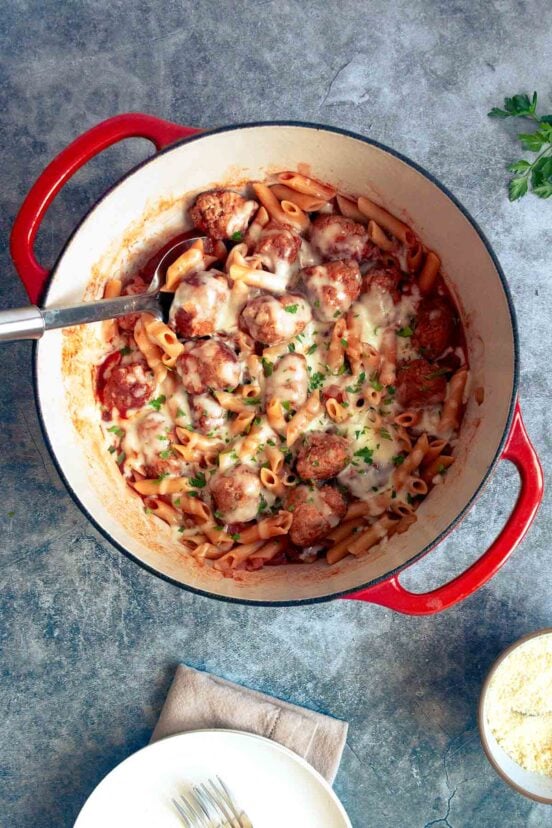
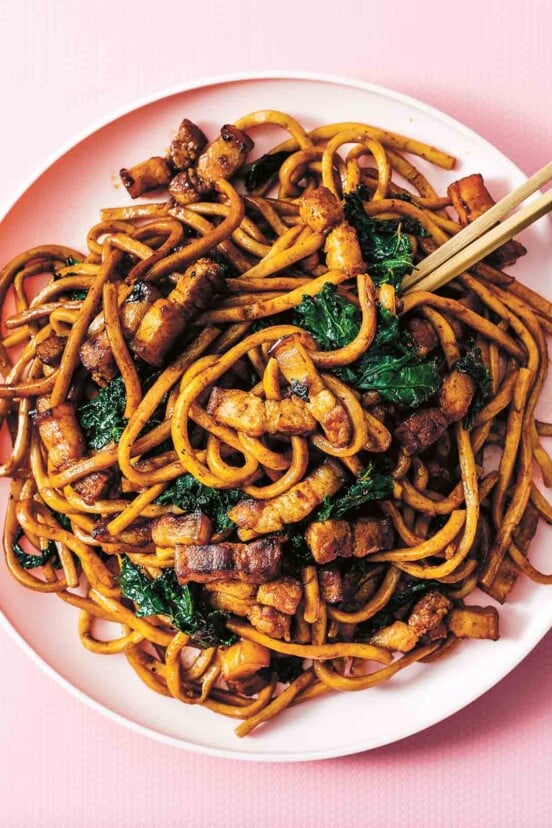
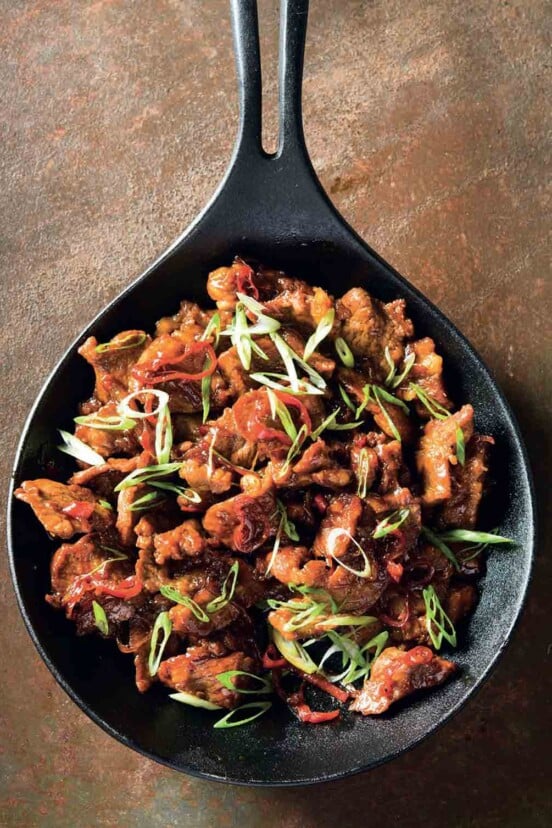









Hi there! Thanks so much for posting this, as I have been coming back to your recipe for the past year or so. Whenever I feel the urge for Pad Thai, I usually have two options: travel for about an hour or so to my favorite Thai restaurant that may or may not have a great hygienic rating or spend some time at the grocery and at home preparing the ingredients for a bit longer than I would like. But as a professional cook I appreciate your simple but amazing ability to make it so easy for everyone. While I know it may not seem so to everyone I know my family definitely loves it. My husband is Asian, and I’m of Caribbean heritage, so we love good food from all cultures and honestly, to us its both perfect and very satisfying!
Sacha, thank you. Nothing makes me happier!
I love pad thai and it is always nice to see a new recipe. I do one with the hated ketchup but it turns out great when you don’t have the authentic Asian ingredients around. I also use chicken but think that whatever protein on hand is good. In any case, to me it is the noodles that can make or break the dish. Too hard or too soft or noodles that have been left to sit in the sauce make for yukky noodles. The book sounds great and I can’t wait to try this rendition! Thanks.
Abbe, I completely agree with you about the noodles. And yes, this is a phenomenal book. If you revel in things Thai and southeast Asian, it’s truly a must.